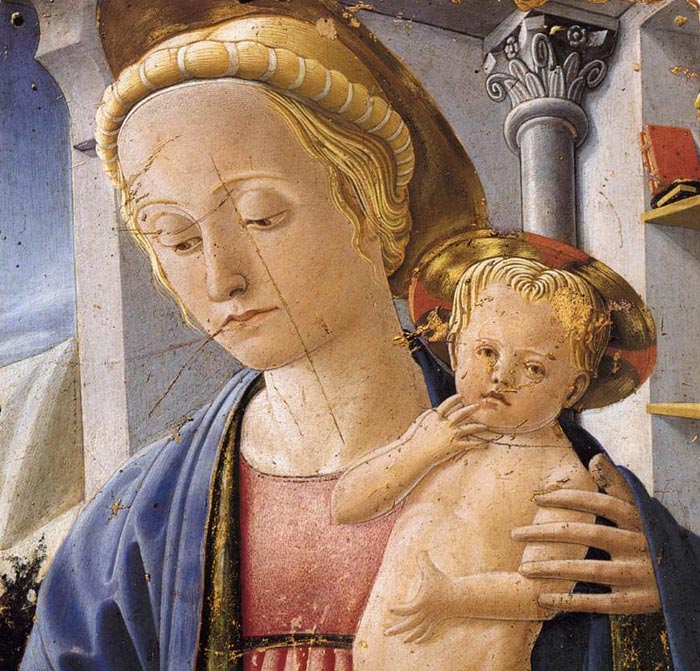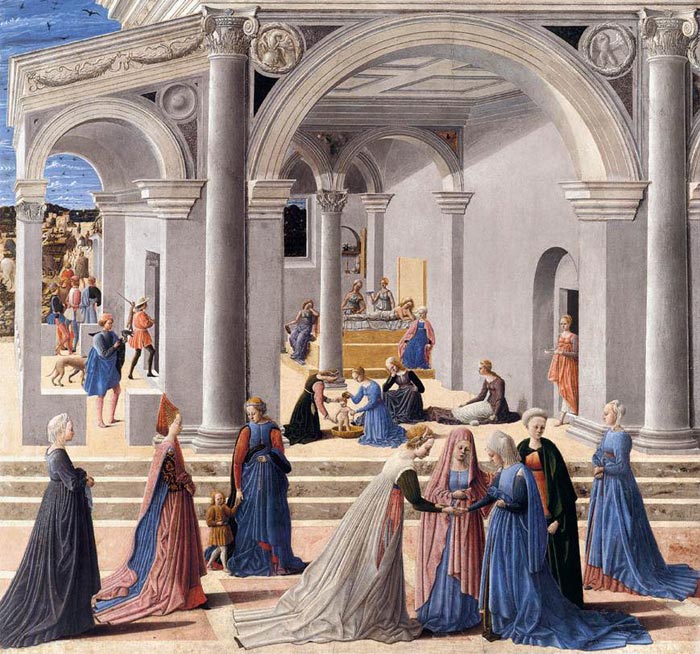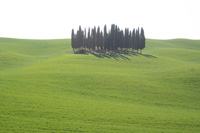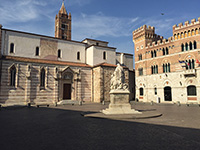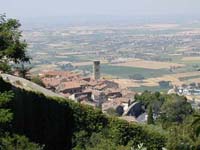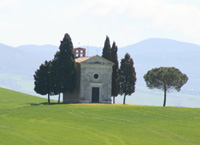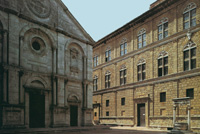| |
|
The Annunciation from the Alte Pinakothek, Munich, was executed for Jacques Coeur (1395-1456), the wealthy finance minister of Charles VII of France (1422-1461), whose coat of arms decorates the door behind the Virgin Mary. Charles was the dauphin (prince), crowned King of France partially through the efforts of the visionary Joan of Arc during a later phase of the Hundred Years' War (1337-1453) between the nascent English and French nations.[1]
On the left-hand side of the composition, nine columns surmounted by foliated Corinthian capitals recede sharply into an increasingly dark background beyond the angel Gabriel. The interior space of the elaborately detailed architecture enclosed by a garden (a Marian symbol of the Virgin's purity) demonstrates the artist's early attempt to master the technique of perspective. Bending ever so gracefully onto an elaborately embroidered carpet in the painting's foreground, Gabriel gestures gently forward to inform the Virgin Mary that she will be the mother of the Christ Child. Within her somewhat spatially restrictive setting, Mary, draped in a rich, deep blue cloak and holding an open text, receives the angel's surprising message concerning her impending fate.
Unquestionably one of the most detailed and exquisite depictions of the Annunciation from the first half of the fifteenth century, this work was painted for Jacques Coeur (1395–1456), the wealthy French merchant and finance minister of King Charles VII, whose coat of arms decorates the door behind the Virgin. Coeur had investments in the eastern Mediterranean as well as in Florence, and the rug beneath the angel must have been intended to appeal to his interests. [2]
|
|
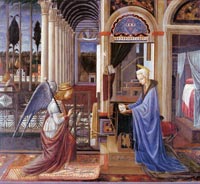 Fra Carnevale, The Annunciation,
Alte Pinakothek, Munich |
The attribution to Fra Carnevale is based on the elaborate architecture and the fascinating perspective: The viewer is encouraged to enter the picture and explore its spaces filled with Marian symbols. The artist clearly studied the work of Filippo Lippi, Fra Angelico, and Domenico Veneziano. The grille behind the angel is related to the work of the sculptor and bronze founder Maso di Bartolomeo and the architecture recalls that of Michelozzo, the Medici's favorite architect.
The Annunciation has a great number of familiar symbols of the Virgin to evoke the life of a patrician Florentine. The Annunciation is shown taking place in an open court before the Virgin's house. Her bedchamber, luxuriously decorated with ermine hangings, curtains, and a small, open cupboard, is seen through a marble door at right. Behind the Virgin a green curtain has been drawn back to reveal the view through another door into a dining room, where a table, stool, and bench are arranged in front of a staircase leading up past an open window. An elaborate bronze grill is shown unlocked, with a key in its open gate. It provides symbolic as well as visual access to an area paved with inlaid marble slabs in front of an altar set up against the exterior wall of the house. Beyond this sanctified area is a deep, colonnaded portico, at the end of which is a door surmounted by an escutcheon supported by two winged putti that leads to an arbour and a closed gate. The walled garden (the 'hortus conclusus') to the left of the colonnade is surrounded by the arbour and contains cyprus trees (symbols of the Virgin), a well (the 'fons hortorum'), a thatched structure of some sort, and peacocks (symbols of immortality).
It is in the domestication of the religious theme and the fastidious attention given to the architecture that Fra Carnevale reveals his authorship. Also characteristic of Fra Carnevale is the system of perspective which is based on the same principles as that found in his Annunciation in Washington.
|
|
|
|
This picture is widely considered the first certain, independent work by Fra Carnevale. It must have been painted about 1450, not long after he left the workshop of Filippo Lippi, whose work is echoed in the delicate, winsome figures. No less important for the color and meticulously plotted perspective is the example of Domenico Veneziano, while the buildings reflect the work of the Medici's favorite architect, Michelozzo. A painting of great refinement, The Annunciation is notable for the way the figures, shown standing on a deserted street instead of in the Virgin's house or a cloister, seem incidental to the architecture.
This painting originally was ascribed to Fra Filippo Lippi. In fact the composition was inspired by two of Lippi's altarpieces, an Annunciation in San Lorenzo, Florence, and another in Munich. From the first of these derive the pose and upward gaze of the angel, the solid haloes with channeling, and the steep perspective of the buildings terminating in a salmon-coloured wall with an open door. From the second, Fra Carnevale has taken the modest stance and gesture of the Virgin.
What is completely original to this depiction is the idea of staging the Annunciation in a street bordered by elegant colonnades rather than in the Virgin's bedroom, a cloister, an enclosed garden, or a church-like interior, as was traditional. The buildings, with their salmon and pink trim, are distinctly Florentine in style, although completely unlike those in Lippi's work. The ornamented arches of two of the buildings recall those in the background of Ghiberti's relief of Solomon and the Queen of Sheba on the Gates of Paradise of the Baptistery in Florence. The perspective system is rigorous: a pinhole indicating the vanishing point has been made in the right doorjamb, eight centimetres from the base of the door; virtually all of the orthogonals recede to this point.
|
|
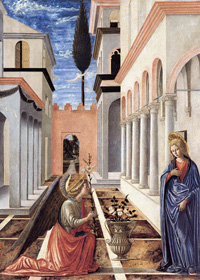 The Annunciation
The Annunciation, about 1445-1450, National Gallery of Art, Washington |
The Birth of the Virgin is apparently a lateral panel from a highly original altarpiece commissioned in 1467 for the Church of Santa Maria della Bella at Urbino. A companion panel, The Presentation of the Virgin, is in the Museum of Fine Arts, Boston. The infant Virgin being bathed by midwives has the character of a genre scene and is embroidered with engaging details from everyday life. The imposing building, decorated with reliefs derived from Roman sculpture, reflects the architecture of the celebrated ducal palace at Urbino. After his training in Florence under Filippo Lippi, Fra Carnevale returned to his native Urbino, where he would have seen works by Piero della Francesca and may have known the great architect-theorist Leon Battista Alberti. The picture originally had an elaborate frame with a series of arches along the top; the present frame is seventeenth-century Bolognese.
Two panels of virtually the same size, depicting scenes constructed on a precisely mirror-image perspective grid, are in the centre of sustained scholarly debate which extends to both the subjects, the function, and the authorship. They depict ostensibly religious subjects with a plethora of detail taken, on the one hand, from contemporary life and inspired, on the other, by humanist-antiquarian interests. One of the panels (in the Metropolitan Museum of Art, New York) represents the Birth of the Virgin, the other (in the Museum of Fine Arts, Boston) probably shows the Presentation of the Virgin in the Temple.
These two highly original pictures can be identified with an altarpiece painted by Fra Carnevale for a lay fraternity of flagellants in the hospital church of Santa Maria della Bella in Urbino. In the seventeenth century the altarpiece was confiscated by Cardinal Antonio Barberini, and in the 1930s they were sold from the Barberini collection to the museums in New York and Boston.
The Virgin (the young girl in blue) is depicted at the head of the procession filing into the basilica-like temple. She passes three beggars - a common embellishment of the scene. Instead of the traditional Jewish priest officiating at the event, Fra Carnevale places three figures at the high altar, apparently a Franciscan, a Dominican and a hooded figure - while two pilgrims are seen against the right-hand entrance pier. The remaining figures in the church are exclusively young males who chat, rest, or walk about. The decorative reliefs on the church façade above clearly depict events in the Virgin's life, The Annunciation and the Visitation. On the basis of the columns a dancing maenad and a satyr with pipes, as well as a classical urn with a branch protruding from its opening symbolize the pagan past.
Newly discovered documents demonstrate that these two panels are probably from Fra Carnevale's most celebrated work, an altarpiece for the oratory of Santa Maria della Bella in Urbino, for which he was paid in 1466. The repainted area along the top reveals the shape of the original frame. The young Virgin is in the center foreground, dressed in blue. The exact subject matter of this panel remains in doubt, since the Virgin neither climbs the steps of the temple nor is welcomed by the high priest, features generally included in depictions of the Presentation. Fra Carnevale, a Dominican friar, was clearly inspired by ancient Roman architecture and sculpture as well as by the new science of linear perspective, which allowed an artist to create the illusion of deep space on a flat surface.
The oratory was attached to a hospital, which may explain the genrelike approach to narration. The emphasis on architecture—clearly inspired by Leon Battista Alberti's architectural treatise—and the oblique treatment of the ostensible subject matter have been the source of discussion for more than a century. In no comparable Renaissance paintings have the religious themes been used as a point of departure for the study of architecture and the suggestion of everyday life (note the beggars in one of the pictures). The paintings originally had frames with a row of arches along the upper edges; these shapes have been painted out but are still visible.
With these works Fra Carnevale established himself as a learned architect and an artist of ingenuity and fantasy (the critical terms of the day would have been ingenio, fantasia, and artificioso).
|
|
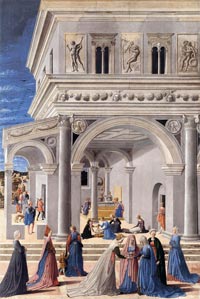
Fra Carnevale, The Birth of the Virgin,
The Metropolitan Museum of Art
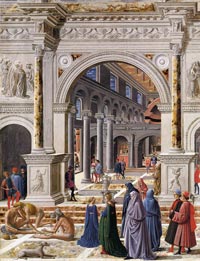
Fra Carnevale, The Presentation of the Virgin, Museum of Fine Arts, Boston
|
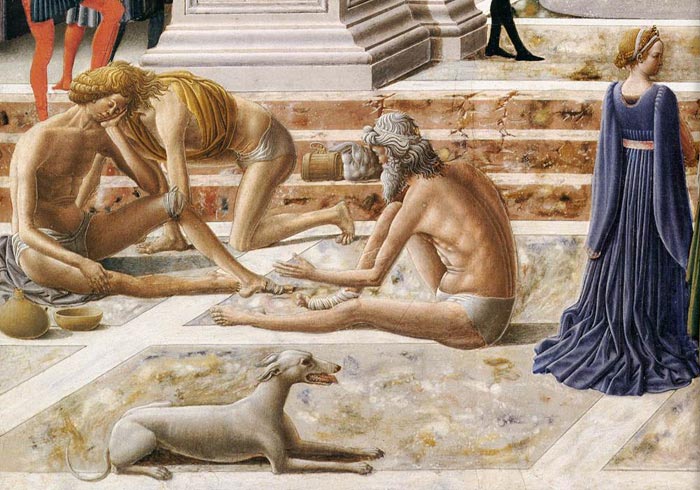 |
Fra Carnevale, Presentation of the Virgin in the Temple (detail), 1467, oil and tempera on panel, 146 x 97 cm, Museum of Fine Arts, Boston
|
The Virgin (the young girl in blue) is depicted at the head of the procession filing into the basilica-like temple. She passes three beggars - a common embellishment of the scene.
|
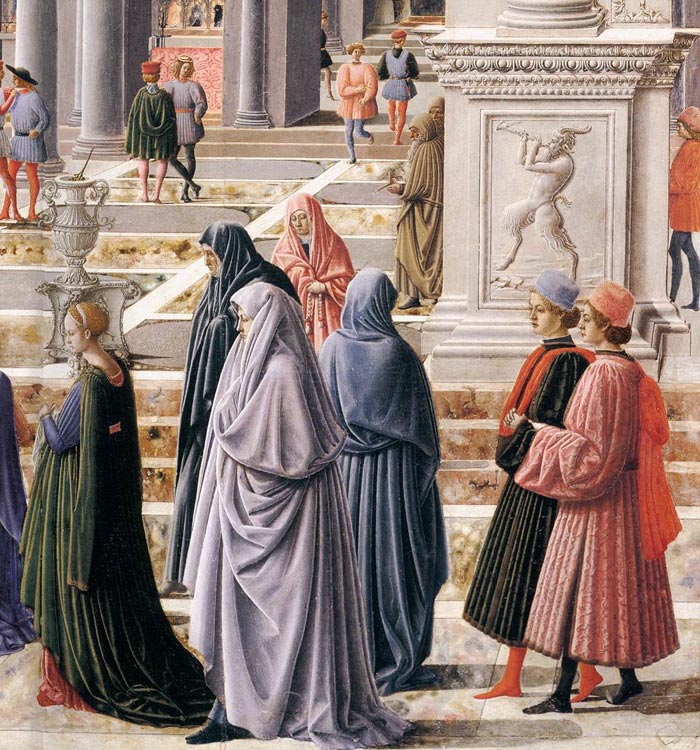 |
Fra Carnevale, Presentation of the Virgin in the Temple, (detail), 1467 Oil and tempera on panel, 146 x 97 cm, Museum of Fine Arts, Boston
|
|
|
| |
|

Florence: Filippo Lippi and Fra Carnevale | The Metropolitan Museum of Art | www.metmuseum.org
This essay, written by Keith Christiansen, was derived from the exhibition catalogue From Filippo Lippi to Piero della Francesca: Fra Carnevale and the Making of a Renaissance Master (The Metropolitan Museum of Art, New York, 2005).
The Early Renaissance in Florence | National Gallery of Art, Washington, DC
This article incorporates material from the Wikipedia article Fra Carnevale published under the GNU Free Documentation License.
Wikimedia Commons has media related to Fra Carnevale. |

[1] 'The style of Fra Carnevale, which draws on older artists like Fra Filippo Lippi, also shows evidence of newer trends, especially in his treatment of distant space. Follow the lines of the architecture: the regular rhythm of arcades and arches recedes into the background. The grid formed by the courtyard measures the distance for our eye.
These converging perspective lines lead to a door beyond which we glimpse a lush garden. This is not a random choice of landscape. The artist has used perspective not simply to create a convincing depiction of space, but to lead us to see the theological implications of his scene. In reference to her virginity, Mary was often called the hortus conclusus (enclosed garden) and the porta clausa (closed door). Many Annunciations translate these themes with visual images of locked doors and walled gardens. Here instead, the perspective takes us through an open door into the heavenly garden of Paradise. The Annunciation, because it is the beginning of Christ's human existence, also heralds the redemption of humankind. The open door underscores the promise of salvation as well as Mary's role in the Incarnation and as intercessor forthe prayers of men and women.' [ National Gallery of Art, Washington, DC | www.nga.gov]
[2] The arms of Jacques Coeur (c. 1395-1456), the wealthy merchant and finance minister of Charles VII are prominently displayed in the tympanum of the door behind the Virgin, indicating that the painting was commissioned by Jacques Coeur who had a special devotion to the Annunciation: the subject is depicted in a magnificent stained-glass window illuminating his family chapel in Bourges Cathedral.
From 1443 to 1451, before being arrested, the Superintendent of Finance of King Charles VII, called Jacques Coeur, had a palace constructed in Bourges, the city where he used to stop between his numerous peregrinations. But he never lived in this palace.
Constructed by an unknown architect, Jacques Coeur’s palace is one of the most beautiful expression of the Gothic civil architecture in its last period, already influenced by the charm and the fancy of the French Renaissance. Jacques Coeur’s arms and his famous motto "Nothing is impossible to a willing heart" appear on the front of the entrance pavilion, just like on the rest of the building, which surrounds an internal courtyard. The austerity of the west front, constructed on the Gallo-Roman enclosure’s place, is opposed to the richness and the charm of the east front, which looms above the street. The extremely decorated interior of the palace expresses the dazzling success of a bourgeois who became rich thanks to his genius. The painting adorning the chapel represents the master of the house, his family and his monarch, among angels, saints and prophets. The palace also attests the new taste for comfort, revealed by the number of fireplaces and by the interior communication system, which separates the official movements of people and things from the private service.
|

The hidden secrets of southern Tuscany | Podere Santa Pia | Residency in Tuscany for writers and artists
|
|
|

. |
|
|
Podere Santa Pia |
|
Podere Santa Pia, garden view, December |
|
Cypress trees between San Quirico d'Orcia and Montalcino |
| |
|
|
|
|
|
|
|
|
|
Grosseto |
|
Cortona |
|
Montalcino |
| |
|
|
|
|
| |
|
|
|
|
Santa Pia is located 3 km from Castigliocello Bandini, 15 km from Abazziia San 't Antimo and Montalcino, close to art cities like Siena, Pienza, Montepulciano and San Quirico d'Orcia, and 1 hour away from the seaside. Grosseto is Tuscany`s most southernly province and is considered to be the capital of Tuscan Maremma. Grosseto is the most southern Tuscan province. The town is situated about 12 kilometres from the sea, in the heart of Tuscan Maremma, a wide alluvial plain. In the past, the lake Prile spread over most of this territory. The lake has almost disappeared due to the drainage works undertaken in this area during the centuries. The various natural reserves surrounding Grosseto witness nonetheless Maremma`s past as a marshland. South of Grosseto flows the Ombrone, the most important river in southern Tuscany. At the river mouth there is the Parco dell`Uccellina.
The ancient city walls built in 1574 under Grand Duke Francesco I de` Medici still surround its historical centre.
Situated in a former marshland that was once infested with malaria, at present the province of Grosseto is a real paradise for those who love culture, nature and good cuisine. Grosseto countryside is scattered with ancient Etruscan towns, such as Roselle, Populonia and Vetulonia. Those who love nature can visit the Parco Naturale della Maremma (Maremma Natural Park), the Riserva Naturale Diaccia Botrona (Diaccia Botrona Nature Reserve) and the Parco Nazionale dell`Arcipelago Toscano (Tuscan Archipelago National Park) and spot some dolphins and whales in the Santuario dei Cetacei (Cetacea Sanctuary). Principina a Mare and Orbetello lagoon are renowned seaside resorts, whereas in the interior there is Saturnia with its famous spas.
|
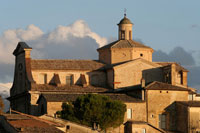
|
|
|
|
|
Montefalco |
|
San Quirico d'Orcia |
|
Pienza |
| |
|
|
![]()
![]()
![]()
![]()

